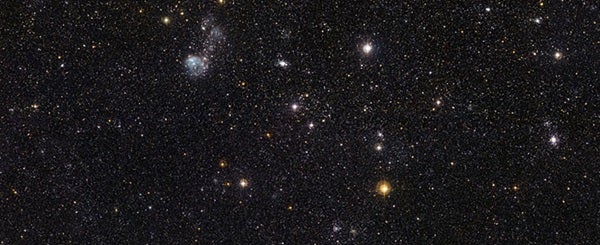Astronomers often turn their telescopes to the Large Magellanic Cloud (LMC), one of the closest galaxies to our own Milky Way, in their quest to understand the universe. In this spectacular new image from the Wide Field Imager (WFI) at the La Silla Observatory in Chile, a celestial menagerie of different objects and phenomena in part of the LMC is on display, ranging from vast globular clusters to the remains left by brilliant supernova explosions. This fascinating observation provides data for a wide variety of research projects unraveling the life and death of stars and the evolution of galaxies.
The LMC is only about 160,000 light-years from our own Milky Way — very close on a cosmic scale. This proximity makes it a very important target as it can be studied in far more detail than more distant systems. The LMC lies in the constellation Dorado the Swordfish deep in the southern sky and well-placed for observations from the European Southern Observatories (ESO) in Chile. It is one of the galaxies forming the Local Group surrounding the Milky Way. Though enormous on a human scale, the LMC is less than one-tenth the mass of our home galaxy and spans just 14,000 light-years compared to about 100,000 light-years for the Milky Way. Astronomers refer to it as an irregular dwarf galaxy. Its irregularity, combined with its prominent central bar of stars, suggests to astronomers that tidal interactions with the Milky Way and a fellow Local Group galaxy, the Small Magellanic Cloud, could have distorted its shape from a classic barred spiral into its modern, more chaotic form.
This image is a mosaic of four pictures from the Wide Field Imager on the MPG/ESO 2.2-meter telescope at the La Silla Observatory in Chile. The image covers a region of sky more than 4 times as large as the Full Moon. The huge field of view of this camera makes it possible to see a wide range of objects in the LMC in a single picture, although only a small part of the entire galaxy can be included. Dozens of clusters of young stars can be seen as well as traces of glowing gas clouds. Huge numbers of faint stars fill the image from edge to edge, and in the background more galaxies far beyond the LMC are visible.
Globular clusters are collections of hundreds of thousands to millions of stars bound by gravity into a roughly spherical shape just a few light-years across. Many clusters orbit the Milky Way and most are ancient, over 10 billion years old, and composed mainly of old red stars. The LMC also has globular clusters, and one is visible as the fuzzy white oval cluster of stars in the upper right part of the image. This is NGC 1978, an unusually massive globular cluster. Unlike most other globular clusters, NGC 1978 is believed to be just 3.5 billion years old. The presence of this kind of object in the LMC leads astronomers to think that the LMC has a more recent history of active star formation than our own Milky Way.
As well as being a vigorous region of star birth, the LMC also has seen many spectacular stellar deaths in the form of brilliant supernova explosions. At the top right of the image, the remnant of one such supernova, a strangely shaped wispy cloud called DEM L 190, often also referred to as N49, can be seen. This giant cloud of glowing gas is the brightest supernova remnant in the LMC, and it is about 30 light-years across. At the center where the star once burned, now lies a magnetar, a neutron star with an extremely powerful magnetic field. It was only in 1979 that satellites orbiting Earth detected a powerful gamma-ray burst from this object, drawing attention to the extreme properties of this new class of stellar exotica created by supernova explosions.
This part of the LMC is so packed with star clusters and other objects that astronomers can spend entire careers exploring it. With so much activity, it is easy to see why astronomers are so keen to study the strange creatures in this heavenly zoo.










